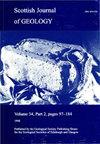苏格兰宾夕法尼亚早期的肺鱼多样性:来自北拉纳克郡下煤系的新肺鱼
IF 1.3
4区 地球科学
Q4 GEOLOGY
引用次数: 0
摘要
在过去的150年里,苏格兰煤系中只记录了两种肺鱼:Ctenodus和Sagenodus。在这里,我们描述了从苏格兰中央煤田采集的一组新的肺鱼标本,这些标本至少代表了四个分类群:Sagenodus;Conchopoma;以及两种新形式的Braccodus kerri gen.et sp.nov和Lanarkodus clarki gen.et sp.nov。它们是最近在德拉姆格雷上下煤矿开采的煤矿废物中发现的广泛脊椎动物群的一部分。这些煤位于Communis时间带内,属于朗赛特时代。这些标本比之前在苏格兰煤系中发现的标本小得多,代表了60至300毫米长的鱼类。Conchopoma的基牙板是该属在欧洲宾夕法尼亚纪的第一个记录。克拉基拉纳科杜斯有一个宾夕法尼亚人以前没有描述过的异齿列。所有新材料都保存在薄层页岩中,这表明这里是一个小湖泊环境,而不是典型的煤沼泽。这些新发现表明,宾夕法尼亚州的肺鱼比以前意识到的更为多样,并为越来越多的证据提供了证据,证明肺鱼的进化率在泥盆纪之后没有显著下降,在整个石炭纪都保持较高水平。主题收藏:本文是苏格兰古生物学收藏的一部分,可在以下网站获取:https://www.lyellcollection.org/topic/collections/palaeontology-of-scotland本文章由计算机程序翻译,如有差异,请以英文原文为准。
Dipnoan diversity in the early Pennsylvanian of Scotland: new lungfish from the Lower Coal Measures of North Lanarkshire
Only two lungfish have been recorded in the Scottish Coal Measures in the past one hundred and fifty years:
Ctenodus
and
Sagenodus
. Here we describe a suite of new lungfish specimens collected from sites in the Scottish Central Coalfield that represent a least four taxa:
Sagenodus
;
Conchopoma
; and two new forms
Braccodus kerri
gen. et sp. nov and
Lanarkodus clarki
gen. et sp. nov. These are part of an extensive vertebrate fauna recently discovered in colliery waste from mining the Upper and Lower Drumgray Coal. These coals lie within the
Communis
Chronozone and are of Langsettian age. The specimens are much smaller than those found previously in the Scottish Coal Measures and represent fish between 60 and 300 mm long. The basihyal tooth plates of
Conchopoma
are the first record of this genus in the Pennsylvanian of Europe.
Lanarkodus clarki
has a heterodont dentition not previously described from the Pennsylvanian. All the new material is preserved in thin, laminated shales, suggesting a small lake environment rather than the typical coal swamp. These new discoveries demonstrate that Pennsylvanian lungfish were more diverse than previously realised and add to growing evidence that the rate of lungfish evolution did not decline significantly after the Devonian, and remained high throughout the Carboniferous.
Thematic collection:
This article is part of the The Palaeontology of Scotland collection available at:
https://www.lyellcollection.org/topic/collections/palaeontology-of-scotland
求助全文
通过发布文献求助,成功后即可免费获取论文全文。
去求助
来源期刊

Scottish Journal of Geology
地学-地质学
CiteScore
1.70
自引率
0.00%
发文量
10
审稿时长
>12 weeks
期刊介绍:
Although published only since 1965, the Scottish Journal of Geology has a long pedigree. It is the joint publication of the Geological Society of Glasgow and the Edinburgh Geological Society, which prior to 1965 published separate Transactions: from 1860 in the case of Glasgow and 1863 for Edinburgh.
Traditionally, the Journal has acted as the focus for papers on all aspects of Scottish geology and its contiguous areas, including the surrounding seas. The publication policy has always been outward looking, with the Editors encouraging review papers and papers on broader aspects of the Earth sciences that cannot be discussed solely in terms of Scottish geology.
The diverse geology of Scotland continues to provide an important natural laboratory for the study of earth sciences; many seminal studies in geology have been carried out on Scottish rocks, and over the years the results of much of this work had been published in the Journal and its predecessors.
The Journal fully deserves its high reputation worldwide and intends to maintain its status in the front rank of publications in the Earth sciences.
 求助内容:
求助内容: 应助结果提醒方式:
应助结果提醒方式:


